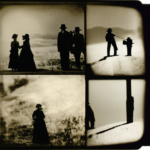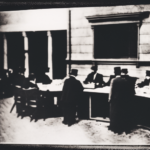One-line summary:
Bloodlands: Europe Between Hitler and Stalin is a chilling and comprehensive account of the atrocities committed by both Nazi Germany and the Soviet Union in Eastern Europe during World War II.
The horrors of the Holocaust and the Gulag:
In Bloodlands: Europe Between Hitler and Stalin, historian Timothy Snyder delves into the dark and often overlooked history of the lands between Berlin and Moscow during the tumultuous period of the 1930s and 1940s. Snyder focuses on the staggering number of deaths that occurred in this region, which he refers to as the “bloodlands.” This term encompasses the areas of Poland, Ukraine, Belarus, and the Baltic states, where millions of innocent civilians were subjected to mass killings, forced labor, and starvation.
Snyder begins by examining the rise of Adolf Hitler and Joseph Stalin, two dictators who unleashed unprecedented violence upon their own people and neighboring countries. He explores the ideologies and policies that drove these leaders to commit such heinous acts, highlighting the similarities and differences between Nazi Germany and the Soviet Union.
The book provides a detailed account of the Holocaust, shedding light on the systematic extermination of six million Jews by the Nazis. Snyder emphasizes the role of mobile killing squads, known as Einsatzgruppen, who carried out mass shootings of Jews and other “undesirable” groups in Eastern Europe. He also delves into the establishment and operation of extermination camps such as Auschwitz and Treblinka, where millions were sent to their deaths in gas chambers.
Snyder then turns his attention to the Soviet Union and its brutal policies under Stalin’s rule. He examines the forced collectivization of agriculture, which resulted in widespread famine and the deaths of millions in Ukraine. The author also explores the Great Purge, during which Stalin ordered the execution or imprisonment of millions of perceived enemies of the state.
The impact on the civilian population:
Throughout the book, Snyder highlights the devastating impact of these atrocities on the civilian population of the bloodlands. He recounts the stories of individuals and communities who were caught in the crossfire of Hitler and Stalin’s power struggles. The book emphasizes the suffering endured by millions of innocent men, women, and children who were displaced, tortured, and killed during this period.
Snyder also examines the complex dynamics between the Nazis and the Soviets, as well as the collaboration and resistance efforts of various groups within the bloodlands. He challenges the notion of a clear-cut division between victims and perpetrators, highlighting the complexities of survival and complicity in such extreme circumstances.
Key takeaways:
- The bloodlands, encompassing Eastern Europe, witnessed unprecedented violence and suffering during World War II, with millions of innocent civilians falling victim to the atrocities committed by both Nazi Germany and the Soviet Union.
- The Holocaust, characterized by mass shootings and extermination camps, resulted in the systematic extermination of six million Jews.
- The Soviet Union under Stalin’s rule was responsible for forced collectivization, widespread famine, and the execution or imprisonment of millions during the Great Purge.
- The book challenges simplistic narratives of victimhood and explores the complex dynamics between victims, perpetrators, collaborators, and resistors in the bloodlands.
“The mass murders of the twentieth century, which were the result of state action, were also a result of state failure. States failed to protect their citizens. States failed to restrain their own officials. States failed to provide the services that might have made life bearable.”
– Timothy Snyder
In conclusion, Bloodlands: Europe Between Hitler and Stalin offers a harrowing account of the atrocities committed by Nazi Germany and the Soviet Union in Eastern Europe during World War II. Snyder’s meticulous research and compelling storytelling shed light on the immense suffering endured by millions of innocent civilians in the bloodlands. This book serves as a stark reminder of the horrors of totalitarian regimes and the importance of understanding and remembering the past to prevent such atrocities from happening again.












